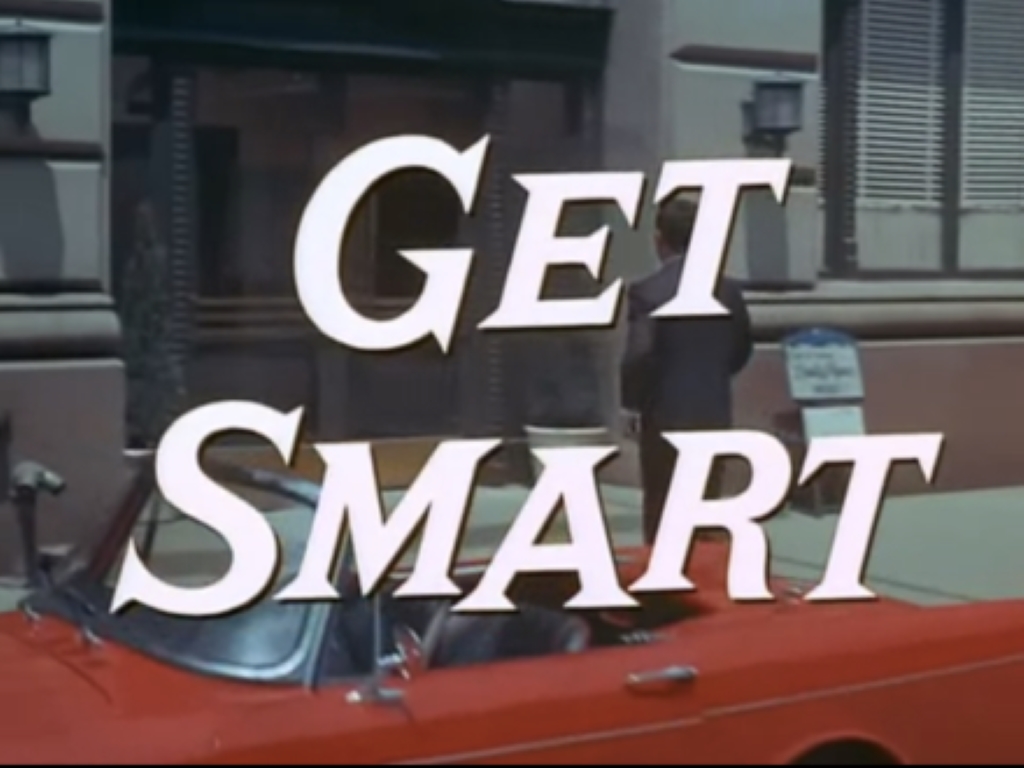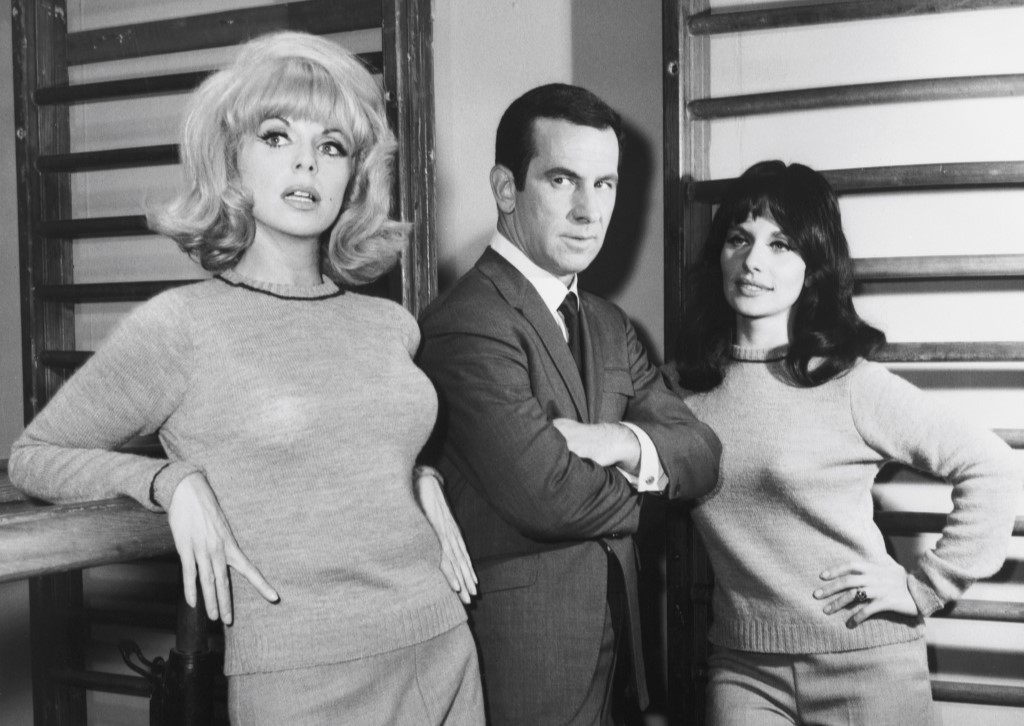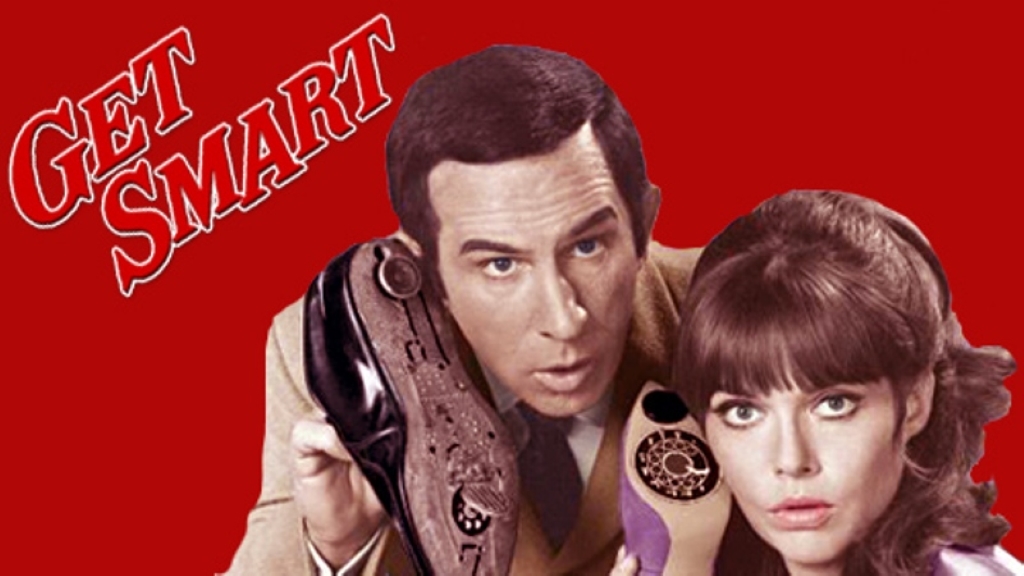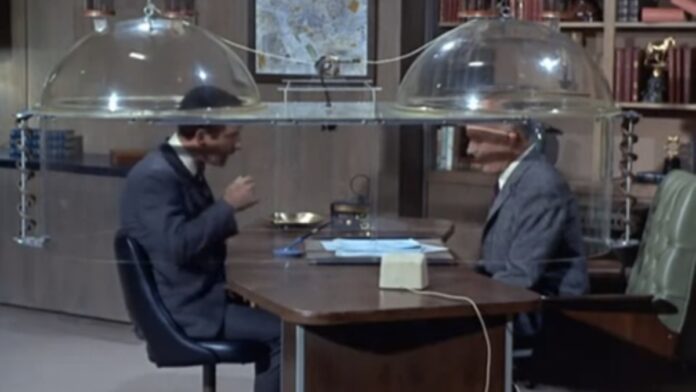Get Smart
Season 1, Episodes 11 and 17: “Too Many Chiefs” and “Kisses for KAOS”
Original airdates: November 27, 1965 and January 15, 1966
Sidant: During my childhood, I didn’t really watch spy-themed shows.
You see, I was more of a comedy enthusiast, spending every available moment watching classic sitcoms that were before my time.
I had a particular fondness for the gimmicky sitcoms of the 1960s, even though I didn’t use that term back then.
I simply found something comforting in the appearance of those well-lit soundstages, the sound of canned laughter, and the absurd yet endearing premise of a witch married to a goofball, a family with a dad who’s a comedic Frankenstein, or a spy organization where the top agent resembles Inspector Gadget.
All of this is my rather indirect way of saying that Get Smart is the only show in this lineup that I’m familiar with.
This series, co-created by Mel Brooks and Buck Henry (although Brooks’s involvement was mainly in the pilot), stars Don Adams as Maxwell Smart, a competent yet clumsy Agent 86 working for the highly classified spy agency CONTROL.
Alongside his resourceful partner, Agent 99 (Barbara Feldon), Smart thwarts various villainous plots hatched by the nefarious organization KAOS.
I loved this show when I was growing up, but I hadn’t revisited it since its reruns on Nick-at-Nite in the early 1990s.
Watching these two episodes, I was delighted to discover that they hold up remarkably well.

This became evident in the opening scene of “Too Many Chiefs,” where a five-way standoff culminates in a hilariously absurd five-way death sequence.
(I must confess that a similar gag in “Kisses for KAOS,” involving a consulate bombing, made me quite uncomfortable in light of recent events in Boston.)
In general, I’m genuinely impressed by how Get Smart strikes a balance between its lighthearted tone and the serious world of espionage.
It’s always a whimsical show, but it doesn’t downplay the genuine stakes. When Max and 99 attempts, in vain, to capture photos and fingerprints of the villainous Sebastian in “Kisses for KAOS,” it’s a farcical situation.
However, the preceding scene between Sebastian and his right-hand man underscores their plan to bomb the Pentagon, lending gravity to the rest of the episode.
The same applies to “Too Many Chiefs,” where the mix-up in identities masks an assassination plot.
The performances of the three main actors significantly contribute to the show’s success. Edward Platt portrays the Chief in a manner akin to Bernard Lee’s portrayal of M in the James Bond films of that era.
He’s essentially a no-nonsense spy boss, issuing actual orders related to national security.
Platt manages to deliver several humorous moments in these episodes, such as his narration of Sebastian’s various disguises, but he approaches both of his roles with the same gravitas.
He’s an authoritative figure in a cartoonish world.
Barbara Feldon handles a lot of exposition and some silly “Max, don’t you realize that I’m a woman too?” moments, but she does so convincingly.
Agent 99 exudes confidence, making her character credible as a spy, even when she’s engaged in absurd activities like trying to get Sebastian to remove his gloves.
However, Max is the central character, and it’s crucial that Max sounds like Don Adams. Adams’s portrayal is key to the show’s success.
Aside from his exaggerated voice, Adams plays the character straightforwardly, allowing us to perceive that Max is genuinely dedicated to his job.
He possesses the skills to be a top-notch spy, even if he occasionally employs them inadvertently to knock out his insurance agent.
If played by a more deadpan leading man in the style of Leslie Nielsen, Get Smart would seem like a poorly executed spy series.
Adams’s performance conveys the show’s essence as a full-fledged spoof.
There are many other aspects to discuss, such as Agent K-13’s appearance, the clever visual gags, and the unfortunate absence of Ricardo Montalban.
I’ll leave some of these topics for others to explore. What did you think of these episodes? How familiar were you with the show before watching it?
Naveen: Get Smart marks the first show we’ve discussed, to which I have childhood memories, although they’re somewhat hazy.
While I was familiar with Blackadder, I didn’t watch it until I was in my late teens.
Like I Love Lucy, Get Smart was a staple on Nick at Nite for me, typically viewed just before bedtime.
It’s amusing how things haven’t changed much; my mother often questioned why I found Get Smart so amusing as a child, and now, as an adult, she wonders why I still enjoy 30 Rock.

Upon watching it again for the first time in many years, I think I’ve figured out why I liked it so much: it’s a live-action cartoon.
Nowadays, people often use this term pejoratively to suggest that a show lacks depth or meaningful stakes.
While Get Smart may not be the most high-stakes series, that hardly matters because everything is played fairly straight.
As you noted, Sidant, particularly Edward Platt’s portrayal, gives the impression that these characters are deeply involved in high-stakes espionage.
I had this cartoonish thought while watching the opening of “Too Many Chiefs” (which, in my opinion, was the funnier of the two episodes we watched for this roundtable; the gadget-centered humor in “Kisses of KAOS” didn’t resonate with me).
In this opening, several agents kill each other off-screen because of a wise guy who doesn’t respect the rules of a standoff.
It’s not dark or played for tragedy, and much like when Daffy Duck gets shot, you wouldn’t be surprised if those poor agents just got back up, unscathed.
The episode continues with this cartoon-level farce with the double chiefs and the wonderful lampooning of the absurdity of ciphers (which deserves to be quoted in full to be fully appreciated):
“The first vowel after every second consonant is superimposed on the vowel immediately preceding it in the alphabet.
The first word after every proposition, if it is not introduced by an article or a personal pronoun, is inverted.
The letter T stands for F, except after E it counts for double. The first number after every second adverb is the third digit after a multiplying adjective.
Proper names and countries equal the word ‘marmalade.'”
I love it. Sidant, I agree with you about Don Adams. He’s simply perfect for the role. I’m not sure what else there is to say about it…
Except that, for the sake of full disclosure, I also liked the 2008 Get Smart movie.
Reesav: You all had unusual childhoods. (I’m joking. Kind of.) The only context I’ve ever encountered beyond the 2008 movie when it comes to Get Smart is comparisons to Chuck.
Having watched these two episodes now, I think that’s a bit of a stretch.
Both are spy comedies, but Get Smart clearly thrives on the escalation of jokes, while Chuck strikes a balance between comedy and drama, seeking genuine dramatic stakes in a rather Shakespearean manner (so that the merriment never truly ends, even though it sort of did in the end).
However, I thoroughly enjoyed these two episodes of Get Smart for a couple of reasons.
First, the progression of comedic mishaps and trials in both episodes is nothing short of delightful.
The show fully exploits its set for some brilliantly choreographed comedic set pieces.
In particular, the painting scene in “Kisses for KAOS” was a particularly hilarious way of illustrating, in a condensed form, how humans make meaning out of absurdity (the black dot representing a fly, naturally).
The standoff scene that opens “Too Many Chiefs” had me bending over with laughter while contemplating whether I should be laughing or not.
It was a perfect subversion of expectations. But that’s nothing compared to the climax of “Too Many Chiefs,” with two Chiefs running amok and two bewildered spies questioning why their chief is behaving so oddly without questioning the absurdity of the situation.
However, I must also acknowledge 99, as she was another significant reason I enjoyed these two episodes.
The character dynamics between 86 and 99 shine through in every scene they share and somehow heighten the romantic hilarity of “Too Many Chiefs.”
Barbara Feldon is a superb straight (wo)man to Don Adams, with the latter often portraying a bumbling character, almost a parody of other spy shows that would come later (or perhaps a parody of the big-screen spy, James Bond 007).
While the Chief plays important roles in the episodes, it’s the two-hander between Feldon and Adams that drives the show, and both excel in their roles.
There’s currently at least one comedy on my DVR that I’m struggling to like, let alone love, and nowadays, I often find it challenging to justify cluttering my DVR with mediocre sitcoms or ones I haven’t stuck with for an extended period (I’m looking at you, How I Met Your Mother).
A major reason for this is the exhaustion I experience while watching shows attempt to provide new takes on classic sitcom tropes or endeavor to create fresh ones from thin air.
Get Smart relies on a solid blend of good-natured wordplay and lively performances, and I’m totally on board with it.
Les: In our initial entry, I mentioned that spy shows have experienced a surge in popularity in recent years.
However, one show I failed to reference was FX’s Archer. Among the many aspects in which Archer excels, one of its best ideas is to highlight the fact that the James Bond archetype is essentially a massive jerk when you look closely, an alcoholic misogynist whose behavior is as likely to end the world as it is to save the day.
Similarly, Get Smart works brilliantly because it satirizes the tropes of espionage fiction, even though it’s a much more good-natured show compared to Archer.

Its signature move is to reveal the lighter side of spying and point out that many of the elaborate and complex plans and devices that the spy genre romanticizes can, when seen differently, be downright silly.
Naveen, you mentioned that you weren’t particularly amused by the gadget-based humor, but I found the array of contraptions they introduced to be delightful.
Yes, we have the classic phone/gun and shoe/phone combinations, but we also have Max’s unwavering commitment to using the Cone of Silence to maintain quiet (and then destroying the Chief’s desk), the dinner specifically engineered to obtain Savage’s fingerprints, the car phone that’s the car itself (“Every time I turn the corner, I dial the operator”), and the top-secret relay rock used for CONTROL communications.
After a while, they all become like Chekovian devices – of course, the gun concealed in the phone will go off unexpectedly, and when there are three types of explosive paint, you know they’ll all come into play at some point.
By the closing scene of “Kisses for KAOS,” I immediately anticipated the pressure-activated paint coming into play simply because they hadn’t used that joke before.
*I’ve watched a few other episodes in addition to these, and the Cone of Silence serves as an amusing recurring gag, as it’s consistently faulty or unnecessary, much to the Chief’s great frustration:
Chief: You know this thing doesn’t work, why do you always insist on using it?! Max: Well, for one thing, it’s 20 degrees cooler inside.
I’m in the same boat as Reesav because I don’t have much experience with Get Smart before this discussion.
However, I was quickly hooked while watching these two episodes.
What I liked most about them was how they took standard espionage plots (protecting a key defector, seducing a suspected enemy agent) and intertwined them with some classic scenarios (a case of mistaken identity, faking a romantic relationship for another purpose).
The interplay between Smart and 99 is vital to the show’s smooth sitcom rhythm. Smart clearly believes himself to be the superior agent but doesn’t assert it, while 99 is mostly bemused by him yet respects his skills.
Beyond their working relationship, there’s a subtle romantic tension, such as when 99 gets annoyed at Smart’s flirtation with Tanya, and Smart takes issue with how close she has to get to Savage.
I expect this romantic tension will become more prominent as the series progresses.
Don Adams as Maxwell Smart, Get Smart, “Kisses for KAOS” Sidant, you previously mentioned Leslie Nielsen, and while watching these episodes, I found myself comparing it to another iconic television spoof, Police Squad! (In Color).
Police Squad! employs a more subtle brand of humor, presenting a straightforward case in a world filled with unacknowledged absurd events.
It relies on Nielsen’s deadpan performance to deliver unintentional jokes and serve as the straight man while bizarre sight gags occur around him.
On the other hand, Get Smart exists in a world where seriousness and humor are more closely blended.
In this world, you can entirely believe that Maxwell Smart would be a top agent because his incompetence operates at the same level as everything else that CONTROL and KAOS are involved in.
Both series are timelessly funny, but I can see why Get Smart ran for 138 episodes compared to Police Squad!’s mere six – it’s easier to sustain a joke when everyone’s in on it.
And yes, I was extremely disappointed that Ricardo Montalban never appeared on the show, thus ending the streak. He would have made a fantastic Rex Savage.
Astha: I’d like to start with a little tangent. A couple of years ago, I fell victim to a particularly vicious stomach virus, and I found myself awake and suffering at 4 a.m. Unable to sleep, I decided to flip through a few channels and stumbled upon old episodes of Murder, She Wrote.
It was like a ray of light. Strangely comforting, kitschy, and charming in its own way. You’d never expect to catch Jessica Fletcher during primetime (obviously), but the peculiar 4 o’clock hour felt just right.
(Much like the current 10 p.m. time slot for She-Ra reruns on Qubo. Sigh.)
Don Adams as Maxwell Smart, Get Smart, “Too Many Chiefs”Get Smart gives me the same kind of vibe: nostalgic, soothing, and entertaining.
I completely understand why reruns of Get Smart graced the screens of Nick-at-Night in the 90s.
It’s one of those mindlessly fun shows that provides sheer enjoyment.
Several aspects of the show reminded me of the physical humor seen in theatrical farces, akin to Noises Off and works by Molière.
The conclusion of “Too Many Chiefs,” with the two Chiefs running around the apartment, is an homage to classic comedic stage conventions.
I thoroughly appreciated Feldon’s portrayal of Agent 99 and found myself coveting almost all of her outfits (so fetch!).
Would I actively seek out Get Smart for a watch? Probably not. Would I tune in if it happened to be on TV very late at night, when I needed something undemanding and relaxing? Absolutely.
Kriti: Ah, yes, “comforting” is the word I would choose to describe the experience of watching Get Smart.
I also have some vague recollections of watching it as a kid, and it’s delightful to find that it’s just as funny as I remember. Revisiting these episodes felt like slipping into an old pair of shoes.
Harry Basch as KAOS Leader, Get Smart, “Too Many Chiefs”Les, I believe you’re spot on when you describe Get Smart as good-natured, especially when compared to more modern shows like Archer.
The humor here is sharp but maintains a classic, Mel Brooks/vaudeville sensibility.
The moment the desk clerk pulls out a gun in the opening of “Too Many Chiefs,” you can anticipate the joke’s trajectory all the way to the punchline, yet it doesn’t diminish its impact.
It’s charmingly old-fashioned in the best possible way. I also found it amusing that, while the agents took the mission seriously, CONTROL and KAOS seemed to exist primarily to oppose each other.
(On a related note, KAOS knows Max’s name and home address, and, in an amusing twist, Max wears a t-shirt with his code name. I can’t quite explain why it amused me as much as it did.)
Watching Get Smart got me thinking, though: why haven’t we discussed Inspector Gadget?
You Might Like To Read: Women in the Box: Katherine Chancellor, The Young and the Restless


